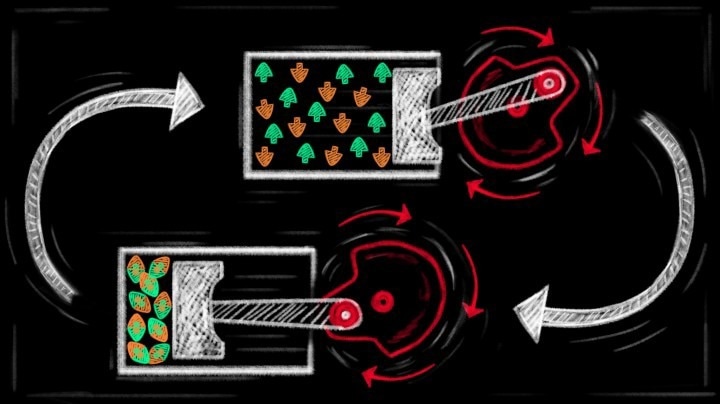Quantum mechanics, a field of physics, delves into the behaviors and relationships of particles at incredibly tiny scales, like atoms and molecules. This exploration has given rise to innovative technologies that surpass traditional ones in terms of power and efficiency, ushering in significant advancements in fields like computing, communication, and energy.

The quantum engine compresses a gas of particles that are bosons and decompresses a gas of particles that are fermions. Image Credit: Mirijam Neve
At the Okinawa Institute of Science and Technology (OIST), the Quantum Systems Unit has partnered with researchers from the University of Kaiserslautern-Landau and the University of Stuttgart to create an engine grounded in the unique principles governing particle behavior at minuscule scales.
They have engineered an engine that harnesses the principles of quantum mechanics to generate energy, departing from the conventional practice of combusting fuel. The findings, detailed in a paper co-authored by OIST researchers Keerthy Menon, Dr. Eloisa Cuestas, Dr. Thomas Fogarty, and Prof. Thomas Busch, have been featured in the prestigious journal Nature.
In a typical classical automobile engine, a blend of fuel and air is typically ignited within a chamber. This ignition event generates an explosion that heats the gas within the chamber. This elevated temperature causes the gas to expand and, in turn, propels a piston back and forth, ultimately producing the mechanical work that powers the car’s wheels.
In their quantum engine, the scientists have substituted the utilization of heat with a transformation in the quantum properties of the gas particles. To comprehend how this transformation can drive the engine, it is crucial to recognize that all-natural particles fall into two categories: bosons or fermions, distinguished by their distinct quantum characteristics.
At extremely low temperatures, where quantum effects come into play, bosons possess a lower energy state compared to fermions.
This disparity in energy levels becomes the driving force behind the engine. Instead of following the traditional cyclic process of heating and cooling gas, as seen in classical engines, the quantum engine operates by converting bosons into fermions and then reverting them back again.
To turn fermions into bosons, you can take two fermions and combine them into a molecule. This new molecule is a boson. Breaking it up allows us to retrieve the fermions again. By doing this cyclically, we can power the engine without using heat.
Thomas Busch, Leader, Quantum Systems Unit, Okinawa Institute of Science and Technology
Although this engine exclusively operates within the quantum realm, the research team discovered that its efficiency is remarkably robust, achieving levels of up to 25% using the current experimental setup crafted by their collaborators in Germany.
This groundbreaking engine represents an exhilarating breakthrough in the domain of quantum mechanics and holds the promise of catalyzing further advancements in the rapidly growing arena of quantum technologies. So, does this mean quantum mechanics will make the car engines work soon?
While these systems can be highly efficient, we have only done a proof-of-concept together with our experimental collaborators. There are still many challenges in building a useful quantum engine.
Keerthy Menon, Researcher, Okinawa Institute of Science and Technology
Elevated temperatures have the potential to obliterate quantum effects, necessitating that researchers maintain their system at the lowest feasible temperature. Still, maintaining these ultra-cold conditions demands a significant energy investment to safeguard the delicate quantum state during experimentation.
Subsequent phases of this research will revolve around tackling fundamental theoretical inquiries concerning the system's functionality, refining its efficiency, and exploring its prospective adaptability to other frequently employed devices, including batteries and sensors.
Journal Reference
Koch, J., et al. (2023) A quantum engine in the BEC–BCS crossover. Nature. doi.org/10.1038/s41586-023-06469-8